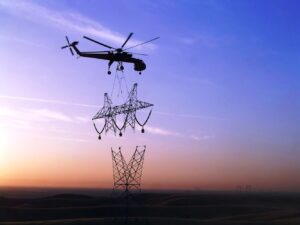Finding ways to evacuate power efficiently is crucial for achieving India’s renewable energy ambitions, notes Naveen Munjal

The world will require large and increasing amounts of power in the coming decades, and the global imperative is to produce this power in clean and sustainable ways. However, it isn’t enough to just generate power, it is equally important that wastage is eliminated or at least minimized.
Power losses have been an area of concern for far too long. The Economic Survey for 2020-21 suggested that transmission and distribution losses in India’s power sector, even until recently, continued to be very high, to the tune of 20 per cent –more than twice the global average. Now, as India works towards its admirably ambitious renewable energy goals, there is need and opportunity to speedily develop and implement solutions for efficient evacuation and transmission of clean energy across the country.
India plans to install 500 GW of non-fossil-based power capacity by 2030.In December 2022, the government outlined a transmission plan to evacuate this power, which entails large-scale establishment of transmission lines, substation capacities, and battery storage to provide uninterrupted power to consumers. The government is also undertaking steps to improve the transmission and distribution infrastructure, even as new private players look with growing interest at transmission, distribution, and other areas of the clean energy chain. These are all encouraging developments, and they will be accelerated by the PM Gati Shakti programmme which, it is hoped, will facilitate coordination between the ministries concerned, and expedite the necessary approval processes.
Challenges in power transmission
As things currently stand, laying power transmission lines continues to pose significant challenges in various forms – difficult terrain, acquiring right of way (RoW), manpower availability and weather conditions, to name a few. Stretched construction timelines to match up with the rapid growth of RE generation is also an area of concern, with most projects encountering substantial delays. The problem is exacerbated for transmission projects that pass through eco-sensitive regions, owing to a lack of clear demarcation of these areas, non-availability of explicit construction guidelines for such projects and the ever-present risk of running into public interest litigation. The Stage-II approval for forest clearances, for instance, is a time-consuming process. It does not help that projects are often delayed owing to inadequate information during the pre-bid stage itself.
Meanwhile, the lead times for procuring major equipment required at power substations– such as gas-insulated switchgear, STATCOMs, 765kV transformers etc. — continues to be as challenging. There is need to develop indigenous manufacturing capabilities for such equipment, and to streamline and standardize the RoW acquisition processes across the country.
Measures so far, and the way forward
The roadmap for the evacuation of upcoming clean-energy capacity should factor all such issues into its timelines. Ideally, it should involve dialogue and partnerships between the industry and the government for identifying and resolving these issues ahead of time. The clean-energy targets that India is working towards can be achieved much faster with timely policy and technology interventions.
The Central government and its agencies, on their part, have already taken certain steps, including the introduction of policies and amendments to the Standard Bidding Guidelines, to address some of the aforesaid challenges and to encourage greater private participation in the sector.
They have had positive effect, with some recent bids seeing as many as 8-10 bidders, on an average. To expedite the award of new projects, bid process timelines have been significantly compressed.
Opportunities for new players, and the role of technology
Today, new private players, including EPC (engineering, procurement and construction) contractors, can enter the power transmission business through the tariff-based competitive bidding route on the back of their prior construction experience. The country has seen many construction companies too, get into the transmission business.
 These developments augur well for the future, because industry reports estimate that India’s transmission sector will need investments of upwards of Rs 5 lakh crore to meet the clean energy targets for 2030.The private sector has the capability to mobilize the resources and know-how to execute such projects efficiently and speedily.
These developments augur well for the future, because industry reports estimate that India’s transmission sector will need investments of upwards of Rs 5 lakh crore to meet the clean energy targets for 2030.The private sector has the capability to mobilize the resources and know-how to execute such projects efficiently and speedily.
Technologies of the day – such as helicopter stringing, helicopter cranes, artificial intelligence, drone cameras, and more— enable building transmission systems safely and with shorter gestation periods. Monitoring transmission lines has become easier than before with the help of drones. Drones have also helped in locating faults quickly and resolving them. AI-based SCADA systems, meanwhile, are bringing greater efficiency to the operations of substations, with minimal human intervention. The usefulness of such technologies was recently evinced in transmission projects in the hilly terrains of Jammu & Kashmir, Ladakh, Uttarakhand, and the northeastern parts of India.
The time for positive change and purposeful action is upon us. India’s ambitions of becoming a low-carbon nation and providing clean and sustainable energy to all, call for dedicated efforts with a long-term vision. How energy is generated, transmitted, and consumed, will all have significant ramifications for not just India’s future but the world’s too.
(About the author: Naveen Munjal is Director – Business Development & Commercial (Conventional), Apraava Energy)


